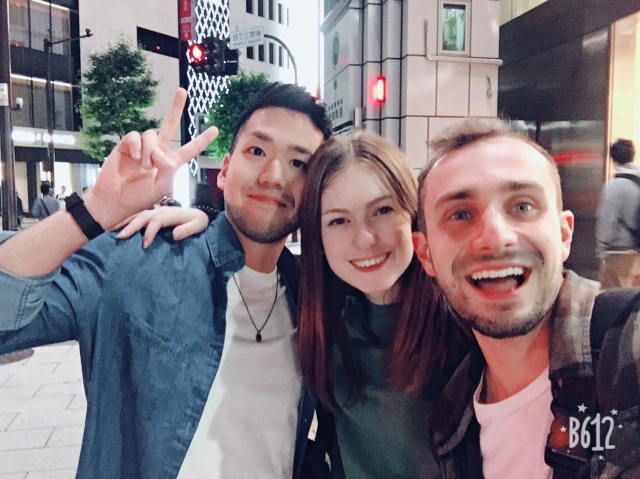このブログを読んでいる人でさ、ありがとうございました。ブログの内容を楽しんで願っています。しかし、このポストは最後のブログです。皆さん、ご苦労様でした。
I can hardly believe that a month has already passed! It feels like I am still getting to know my roommate and the people living at i-house. Because even though it has been more than a week since I left i-house to do my own traveling, it honestly just feels like I’m on another homestay visit. My mind can’t grasp the fact that I’m not going to wake up in my dorm room on Monday, shuffle to the shower (all the while trying not to wake up my roommate) and then run to class. I think I adjusted to life in Japan a bit too quickly; when I return back to Canada, the transition back is not going to be easy.
Our group blog was focused around social issues, and I think this has kind of opened my eyes towards somethings. I was lucky to have a chance to become friends with someone who is very critical of society (not just Japanese society, but societies all over the world) and how humans just tend to fall into certain collective habits. Hanging around them made me realize the benefits and faults of living in a certain society. For example, when it comes to job-hunting in Japan, fourth year students are usually forced by their peers to start looking for jobs, even before graduating. In Canada, companies will not hire you unless you have already graduated university. However, for both countries, companies that hire young people usually offer little to no pay internships. And these internships usually have these young people doing grunt work or “chores”, as I like to put it, such as fetching coffee for superiors, or translating small PowerPoint Presentations. Reflecting back on the blogs were wrote here, we should have done a greater focus on comparing AND contrasting the social issues of different societies.
It has been a pleasure to study and travel Japan. I hope to be back soon!
April Grace Petrascu
エイプリル・グレイス・ペットラスキュ


 This time in Japan is the third time I have had the opportunity to come here. Every time I come here I have more and more friends to visit which I am so thankful for. I get to really experience the culture that way and my friends show me around to places that I may not have found otherwise. My Japanese friends that live in various cities around Japan really make the whole experience for me. I have got to meet more amazing people, test out my Japanese, visit universities and learn more about life here. Each time visiting Japan gets better and better for me. I don’t do many touristy things because I would rather spend time with people.
This time in Japan is the third time I have had the opportunity to come here. Every time I come here I have more and more friends to visit which I am so thankful for. I get to really experience the culture that way and my friends show me around to places that I may not have found otherwise. My Japanese friends that live in various cities around Japan really make the whole experience for me. I have got to meet more amazing people, test out my Japanese, visit universities and learn more about life here. Each time visiting Japan gets better and better for me. I don’t do many touristy things because I would rather spend time with people.



 As I (Karmen) am Asian I don’t stand out as much as others in the group here, but I still get looked at because I speak a different language and dress differently. Whenever I hang out with our group member Deylan, I realize how the Japanese just stares at her. This happens more commonly when we are at the university or walking around Kawasaki-shi. It is a lot better when we are at touristy areas like Shibuya, Shinjuku and Harajuku, as there are many other tourists as well. Every time we walk out of the I-house, Deylan gets an extraordinary amount of attention from the locals. Attention as not in subtle looks, but literally side glares, full body checkouts and comments in Japanese. Although, the people are just curious and of course our Deylan is very pretty, it can still be very uncomfortable and awkward. As the comments are usually just “可愛い” or “アメリカ人” it is actually kind of funny, especially when we can understand. I find it interesting how they quickly associate Deylan as an American because of her appearance. Deylan has also gotten other special attention such as, a camera crew showing interest in having her in whatever they were filming and interview request.
As I (Karmen) am Asian I don’t stand out as much as others in the group here, but I still get looked at because I speak a different language and dress differently. Whenever I hang out with our group member Deylan, I realize how the Japanese just stares at her. This happens more commonly when we are at the university or walking around Kawasaki-shi. It is a lot better when we are at touristy areas like Shibuya, Shinjuku and Harajuku, as there are many other tourists as well. Every time we walk out of the I-house, Deylan gets an extraordinary amount of attention from the locals. Attention as not in subtle looks, but literally side glares, full body checkouts and comments in Japanese. Although, the people are just curious and of course our Deylan is very pretty, it can still be very uncomfortable and awkward. As the comments are usually just “可愛い” or “アメリカ人” it is actually kind of funny, especially when we can understand. I find it interesting how they quickly associate Deylan as an American because of her appearance. Deylan has also gotten other special attention such as, a camera crew showing interest in having her in whatever they were filming and interview request.








